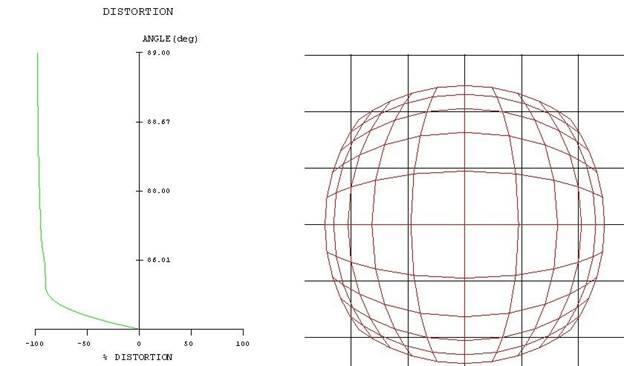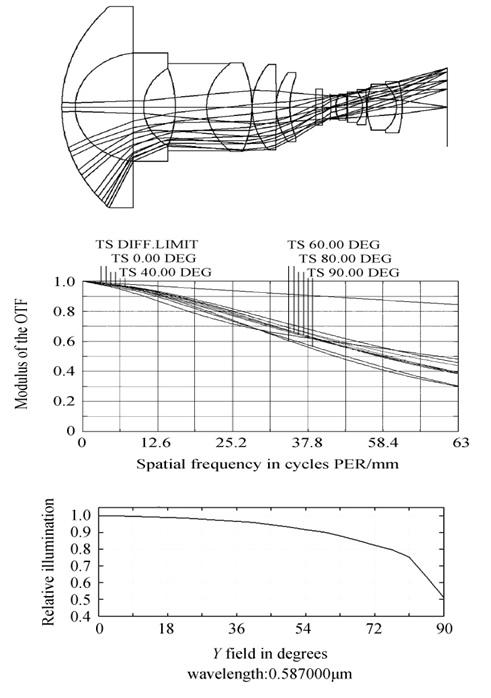Please contact us for latest price on stock parts and custom specifications.
A fisheye lens is a type of wide angle lens which can capture an extremely wide field of view. While a rectilinear wide angle lens can capture a field of view of 100 degrees, the fisheye lens can capture a field of view ranging from 100 to 180 degrees but with a circular image. Such lenses introduce a large amount of barrel distortion and straight lines are only possible at the center of the frame. They are especially designed to create a wide panoramic or hemispherical view without blind spots. Fisheye lenses are widely used in a variety of applications such as sky projection and dome movie projection in the planetariums, surveillance cameras, car cameras, security cameras, scientific photography, etc.
Based on how the image circle fulfills the camera sensor, camera fisheye lenses can be categorized by two different types: diagonal fisheye lens and circular fisheye lens. A diagonal fisheye lens refers to a fisheye lens which is designed to have a 180-degree field of view over the sensor diagonal. For this kind of fisheye lens, the actual horizontal and vertical field of view of the rectangular image are smaller than 180 degrees. A circular fisheye lens refers to a fisheye lens which is designed to have a 180-degree field of view over the sensor width. Since an image sensor usually is rectangular and diagonal length is larger than the fisheye image circle diameter, the corners of the image are completely black.
The focal length of fisheye lenses is short and its value is determined by the sensor format. For a (35 mm film) full frame sensor, usually focal length of fisheye lenses is not larger than 10 mm for circular images, and not larger than 16 mm for full-frame images. The focal length of fisheye lenses can be as short as 1 to 2 mm for digital cameras using smaller electronic imagers such as, 1⁄4 “, 1⁄3″ and 1⁄2” format CCD or CMOS sensors.
As a unique type of camera lens, fisheye lenses have some special properties when compared to other ordinary camera lenses. A fisheye lens should be an inverted telephoto lens due to the large FOV and short focal length. In order to direct all the light rays from an entire hemisphere into the aperture stop, fisheye lenses usually have more than one negative lens elements in the front group to reduce the ray angles. The rear group of the fisheye lens needs to be positive to compensate the total power of the lens. For accurately tracing the rays of a fisheye lenses with large pupil aberration, the ray aiming algorithm needs to be turned on in the optical design software.
Shanghai Optics can optimize the entire process of designing and producing these fantastic lenses, which can help you receive high quality fisheye lenses in efficient ways.
To capture the entire hemisphere with a fisheye lens, strong barrel distortion needs to be introduced. The image close to the edge needs to be compressed when compared to the center of the image. When using the traditional f-tanθ projection method to calculate the image height, fisheye lenses with a 180-degree FOV can have -100% distortion at the edge of the image circle. The following figures show the f-tanθ distortion and image of a rectilinear object.

A peek at Shanghai Optics Fisheye Lens design optimization process and Fisheye Lens assembly.
The following figures show the design and imaging performance of a fisheye lens with a focal length of 14mm, f/number of 2.8. The lens is designed to work at the visible and near infrared wavelength range and have a 180-degree field of view over the diagonal of a 35mm film (full frame) format. The fisheye lens has a F-Tan(Ɵ) distortion of -100% at the edge of the image circle. The F-theta distortion of this lens is lower than 3%. The MTF is above 30% at spatial frequency of 631p/mm over the entire field of view. The relative illumination is above 50% at the edge of the viewing angle.

We design and produce high quality fisheye lenses that are used in a wide range of digital cameras with sensors from 1⁄4 “, 1⁄3″ and 1⁄2” to large format including fourth thirds sensor and 35mm film format. At Shanghai Optics, we have over 55 years of design and manufacturing experience to provide high quality designs and custom lenses for our customers.
Request a free quote from S.O. online, or contact a representative to learn more about our capabilities.